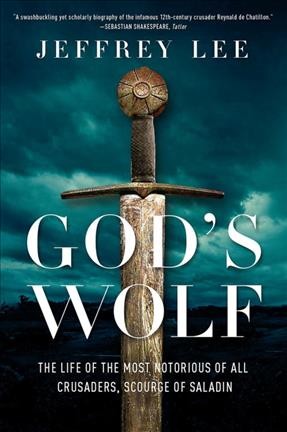 This book opens with an attempted terrorist attack in the early 2000s. A mail bomb intended to blow up over Chicago. The attack was foiled but the package containing the bomb was addressed to a man dead for hundreds of years: Reynald de Chatillon a knight who lived most of his life fighting Muslims (and in many cases Christians) in the Holy Land. In the process he gained a reputation as brutal and ruthless opponent. Down through the ages, Reynald came to epitomize everything that was wrong with the Crusader movement of the Middle Ages. It’s bigotry, its rapaciousness, and its religious extremism. Jeffrey Lee though, takes a different view. He argues in God’s Wolf that Reynald was no worse than most of his fellow Crusader knights but was rather a victim of bad press from both his fellow Christians and Muslims and his own flamboyant way of plying his trade.
This book opens with an attempted terrorist attack in the early 2000s. A mail bomb intended to blow up over Chicago. The attack was foiled but the package containing the bomb was addressed to a man dead for hundreds of years: Reynald de Chatillon a knight who lived most of his life fighting Muslims (and in many cases Christians) in the Holy Land. In the process he gained a reputation as brutal and ruthless opponent. Down through the ages, Reynald came to epitomize everything that was wrong with the Crusader movement of the Middle Ages. It’s bigotry, its rapaciousness, and its religious extremism. Jeffrey Lee though, takes a different view. He argues in God’s Wolf that Reynald was no worse than most of his fellow Crusader knights but was rather a victim of bad press from both his fellow Christians and Muslims and his own flamboyant way of plying his trade.
Reynald came from the Burgundy region of France. The second son of a noble family he joined the Second Crusade that set out for the Holy Land in 1147 to make his fortune. The First Crusade had established several Christian states in the Holy Land a hundred years earlier. One of these, The County of Edessa, had fallen to the Seljuk Turks and the Second Crusade was meant to recapture it. After reaching the Holy Land, unlike many crusaders who stayed for a season and went home, Reynald stayed in Antioch until a really advantageous marriage rocketed him to the top of the social ladder. From there he would dominate military and political affairs for the next 40 years with the exception of a 15 year stent in the dungeons of Aleppo. In that time he fought a wide variety of Muslims, Armenian Christians, Byzantine Christians and his fellow crusaders. Basically anyone who threatened his power. His Muslim enemies created ever more extravagantly awful descriptions of him and his enemies among the Christians were more than happy to write these and more down for future generations. However as Lee points out again and again Reynald acted exactly as a 12 century knight was expected to act and that many of this fellow knights did similar things they just weren’t as good at them and didn’t have as many enemies to write about their exploits.
The writing style of this book is very approachable. Don’t know anything about medieval crusader states? No problem, Lee lays out their creation succinctly and clearly. At the same time he weaves in his argument without beating the reader over the head with it. All the while drawing a vivid picture of the time and place. The one frustration about the book (and this is true of most books studying the middle ages) there are huge gaps of time where Lee can only speculate what might have happened to Reynald because there simply is no record of him.
In short a great book for anyone who loves the crusades or medieval history.


